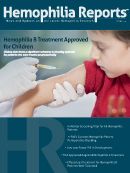Treatment for Hemophilia B Patients Is Effective, Well-Tolerated
Nonacog beta pegol was well-tolerated and effective for treatment of bleeding episodes in hemophilia B patients, and was associated with low annualized bleeding rates.

Bleeding episodes were effectively treated by nonacog beta pegol and was associated with low annualized bleeding rates in hemophilia B patients, according to a study published in Blood.
Researchers from the Arthur Bloom Hemophilia Center at Cardiff University in the United Kingdom examined 74 hemophilia patients which had been previously treated in order to evaluate the safety and efficacy of nonacog beta pegol, a recombinant glycoPEGylated factor IX with an extended half-life. The patients were divided into 3 groups: 30 patients received weekly prophylaxis 10 IU/kg for 52 weeks; 29 patients received weekly prophylaxis 40 IU/kg for 52 weeks; and 15 patients received on-demand treatment for 28 weeks. Patients receiving weekly treatment averaged 54 exposure days, while the on-demand treatment group averaged 14 days.
The investigators identified 345 bleeding episodes which came from 55 patients (74 percent). A third of the episodes were classified by researchers as traumatic (33.6 percent) while the remaining 65.8 percent of episodes were considered spontaneous. More than half (202 episodes) came from the weekly prophylaxis group and 143 came from the on-demand treatment group. A majority (78.5 percent) of the bleeding episodes occurred in joints.
Successful treatment of bleeding episodes was calculated to be 92.2 percent. More episodes were resolved after 1 injection of nonacog beta pegol in the weekly 40 IU/kg group (98.6 percent) than in the weekly 10 IU/kg group (84.1 percent). The on-demand treatment group was 83.9 percent successful in controlling bleeding episodes.
Half of the patients (52 percent) in the weekly 40 IU/kg treatment group did not require any treatment from the bleeding episodes, while 17 percent and 7 percent in the weekly 10 IU/kg and on-demand treatment groups, respectively, did not require treatment. Researchers pointed out the annualized bleeding rate was lower in the weekly 40 IU/kg treatment group, than in the weekly 10 IU/kg and on-demand treatment groups.
Researchers determined the weekly 40 IU/kg treatment group experienced the greatest improvements in quality of life, based on baseline scores of about 75 to 90 by the end of the trial on the EuroQOL-5 Dimensions scale.
Adverse events were experienced by 60 patients (81 percent) for a combined 215 events. Most commonly, these adverse events were nasopharyngitis (13.5 percent), influenza (10.8 percent), and upper respiratory tract infection (10.8 percent). The researchers noted no patients developed an inhibitor. They also noted there were no deaths, thromboembolic events, or allergic reactions to the treatment.
“Nonacog beta pegol was effective for the treatment of bleeding episodes in both prophylaxis and on-demand patients,” Peter W. Collins, MD, and colleagues concluded. “Low bleeding rates were observed in patients on prophylaxis and are likely related to high trough levels due to the extended half-life of nonacog beta pegol. These data suggest that once-weekly prophylaxis with nonacog beta pegol may provide a new and safe alternative for the prevention and treatment of bleeding episodes in patients with hemophilia B.”
